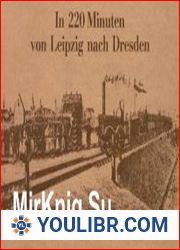
BOOKS - TECHNOLOGY - 150 Jahre erste Deutsche Ferneisenbahnstrecke Leipzig-Dresden

150 Jahre erste Deutsche Ferneisenbahnstrecke Leipzig-Dresden
Year: 1990
Format: PDF

Format: PDF

Long Description of the Plot: The book "150 Jahre erste Deutsche Fern Eisenbahnstrecke Leipzig-Dresden" tells the story of the first long-distance railway line in Germany, which was built 150 years ago. The book explores the history of this significant infrastructure project, from its planning and construction to its impact on the economy and society of the region. It highlights the challenges faced by the engineers, politicians, and investors who worked tirelessly to bring this vision to life. The book begins with an introduction to the historical context of the time, explaining how the idea of building a railroad connecting the cities of Leipzig and Dresden emerged during a period of rapid industrialization and urbanization in Germany. The author delves into the technological advancements that made this feat possible, such as the development of steam engines and the improvement of tracks and locomotives. As the story unfolds, readers learn about the obstacles that had to be overcome, including geographical challenges like mountains and rivers, and political challenges like funding and land acquisition. The book also highlights the contributions of key figures like the king of Saxony, Frederick Augustus II, who played a crucial role in the project's success. The book then delves into the social and economic impact of the railway line, discussing how it transformed the lives of people living along the route.
Длинное описание сюжета: Книга «150 Jahre erste Deutsche Fern Eisenbahnstrecke ipzig-Dresden» повествует о первой в Германии железнодорожной линии дальнего следования, которая была построена 150 лет назад. Книга исследует историю этого значимого инфраструктурного проекта, от его планирования и строительства до его влияния на экономику и общество региона. В нем освещаются проблемы, с которыми сталкиваются инженеры, политики и инвесторы, которые неустанно работали над воплощением этого видения в жизнь. Книга начинается с введения в исторический контекст того времени, объясняющего, как возникла идея строительства железной дороги, соединяющей города Лейпциг и Дрезден в период быстрой индустриализации и урбанизации в Германии. Автор углубляется в технологические достижения, которые сделали этот подвиг возможным, такие как разработка паровых машин и улучшение путей и локомотивов. По мере развития истории читатели узнают о препятствиях, которые необходимо было преодолеть, включая географические проблемы, такие как горы и реки, и политические проблемы, такие как финансирование и приобретение земли. В книге также освещается вклад ключевых фигур, таких как король Саксонии Фридрих Август II, которые сыграли решающую роль в успехе проекта. Затем книга углубляется в социальные и экономические последствия железнодорожной линии, обсуждая, как она изменила жизнь людей, живущих вдоль маршрута.
Lunga descrizione della trama «150 Jahre erste Deutsche Fern Eisenbahnstrecke ipzig-Dresden» racconta la prima linea ferroviaria a lunga percorrenza in Germania, costruita 150 anni fa. Il libro esplora la storia di questo importante progetto infrastrutturale, dalla sua pianificazione alla sua costruzione fino al suo impatto sull'economia e sulla società della regione. In esso vengono illustrati i problemi che gli ingegneri, i politici e gli investitori hanno affrontato per mettere in pratica questa visione. Il libro inizia con l'introduzione nel contesto storico dell'epoca, che spiega come è nata l'idea di costruire una ferrovia che collega le città di ipzig e Dresda in un periodo di rapida industrializzazione e urbanizzazione in Germania. L'autore approfondisce i progressi tecnologici che hanno reso possibile questo exploit, come lo sviluppo di macchine a vapore e il miglioramento di percorsi e locomotive. Mentre la storia si sviluppa, i lettori scopriranno gli ostacoli da superare, inclusi i problemi geografici, come le montagne e i fiumi, e i problemi politici, come i finanziamenti e l'acquisto di terreni. Il libro illustra anche il contributo di figure chiave, come il re della Sassonia, Friedrich August II, che hanno avuto un ruolo decisivo nel successo del progetto. Poi il libro approfondisce le conseguenze sociali ed economiche della linea ferroviaria, discutendo come ha cambiato la vita delle persone che vivono lungo il percorso.
''








 49
49  1 TON
1 TON













![Die elemente des gotischen : eine erste einfuhrung in die deutsche sprachwissenschaft von Friedrich Kluge 1911 [Leather Bound] Die elemente des gotischen : eine erste einfuhrung in die deutsche sprachwissenschaft von Friedrich Kluge 1911 [Leather Bound]](https://youlibr.com/img/9/962951_oc.jpg)

























